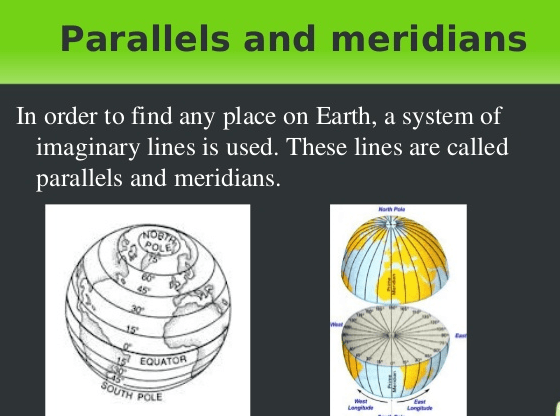Parallel and meridian

The Difference between Parallel and Meridian is given here. Parallel and meridian are two geographical concepts that we can get to confuse. However, they are different, the parallel is the circle that is formed by the intersection of the sphere with the plane perpendicular to the axis of rotation while a meridian The meridians are the semicircles that pass through the poles and whose utility is to determine the length of any place on earth.
keep reading…
Parallel
The parallels are the circles formed by the intersection of the earth’s geoid with an imaginary plane that is perpendicular to the axis of rotation of our planet.
From the Greenwich meridian and on the parallels, the latitude is measured. It is the arc of circumference in sexagesimal degrees from east to west. They are not great circumferences with the exception of the equator. The angle formed on any meridian plane by a parallel and the equatorial line is called latitude.
The five main parallels are:
- Polar Circle.
- Tropic of Cancer.
- Ecuador.
- Tropic of Capricorn.
- Antarctic polar circle.
Ecuador divides the planet into two zones, north and south. It coincides with the maximum and minimum declination of the Sun in this, reaches great heights and culminates in the zenith twice a year. In the two temperate zones, the zones between the tropics and the polar circles, the sun never reaches its zenith.
Meridian
The meridians are the maximum semicircles that pass through the terrestrial globe and pass through the North and South Poles. They are also the maximum semicircles that pass through the poles of any sphere.
Its usefulness is to determine the longitude of any place on earth with respect to a reference meridian, adding the latitude, which is determined by the parallel that crosses that point. It is also used to calculate the time zone, that is, all observers located on the same meridian have the same time.
suggested video: Parallel vs Meridian
Difference between Parallel and Meridian
- Parallels are lines that cross the globe and are parallel to the axis of rotation.
- The parallels are not great circles.
- Meridians are circumferences that pass through the north and south poles of the planet or a sphere.
- The meridians are great circumferences.
- The parallel measures the length.
- Meridians measure latitude.